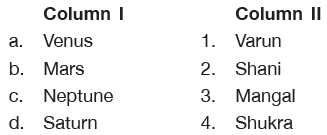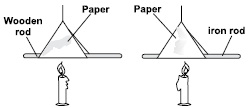Subject :NSO Class : Class 8
Subject :NSO Class : Class 3
Ans 1:
Class : Class 9
The correct answer is D as the bicycle is two-wheeler and the others are four-wheeler.
Post Your Answer
Subject :NSO Class : Class 5
Post Your Answer
Subject :NSO Class : Class 3
Post Your Answer
Subject :NSO Class : Class 3
Ans 1: (Master Answer)
Class : Class 1
C

Equator receives almost the same amount of sunlight throughout the year. and has days and nights of equal duration i.e.,12 hours each.
Poles receive sunlight only for 6 months and remain dark for the next 6 months.
Post Your Answer
Subject :NSO Class : Class 4
Ans 1: (Master Answer)
Class : Class 1
C
The hindi names of Venus, Mars, Neptune and Saturn are Shukra, Mangal, Varun and Shani respectively.
Post Your Answer
Subject :NSO Class : Class 3
Post Your Answer
Subject :NSO Class : Class 7
Post Your Answer
Subject :NSO Class : Class 6
Post Your Answer
Subject :NSO Class : Class 4















